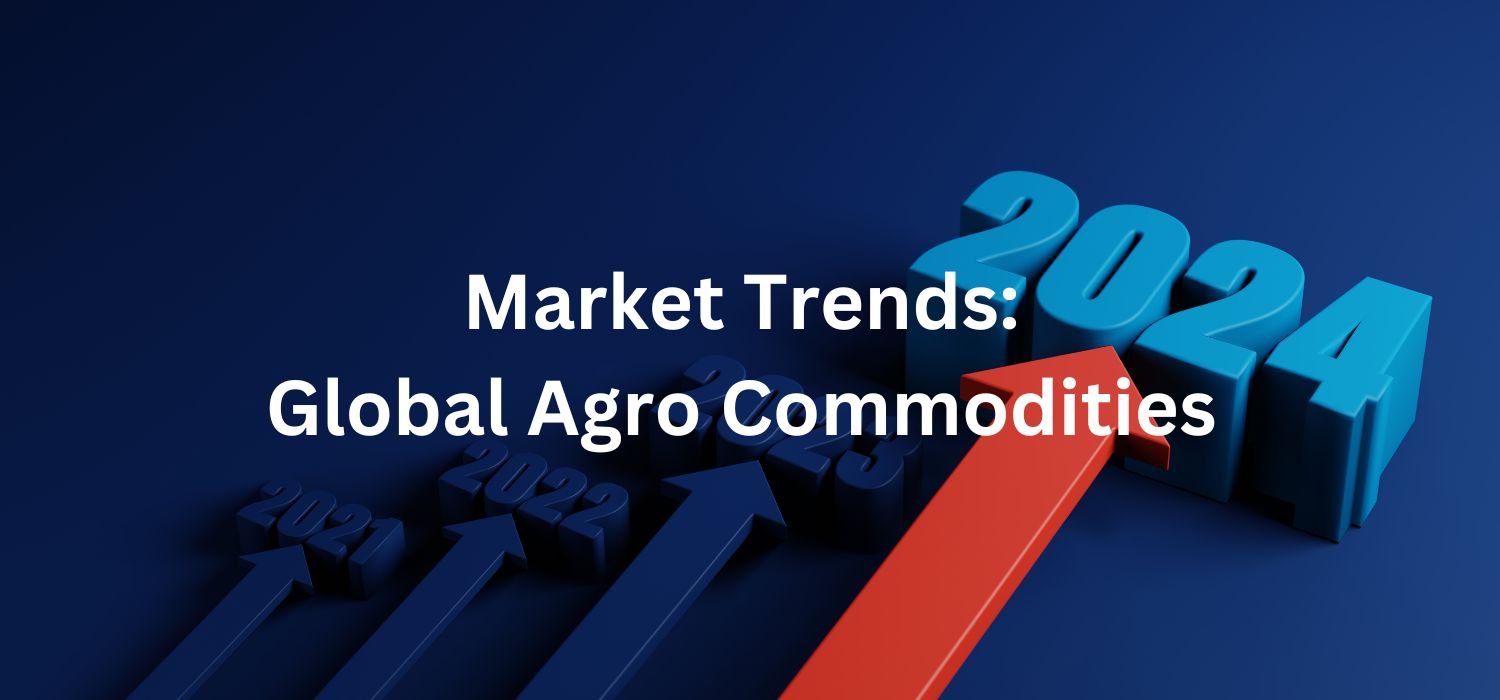Introduction In India, the majority of income comes from the agricultural sector. The nation ranks among the top producers of food items and agricultural goods worldwide. The growth rate of India’s agriculture sector predicted to be 3.5% in 2022–2023 and 3.0% in 2021–2022. In agriculture and related industries, the gross value added (GVA) increased by […]
Market Trends in Global Agro Commodities: What to Watch in 2024
8 Mar, 2024

In the evolving world of global agriculture, farmers, traders, and stakeholders need to remain updated with market trends. As we step into 2024, the world of agricultural commodities is about to undergo major changes.
The projection for the next ten years is a 1.2% annual growth in global demand for agricultural commodities (including non-food applications). This growth rate is significantly lower than the 2.2% annual growth seen in the previous ten years.
Let’s explore key market trends, analyzing what to watch out for in the dynamic realm of global agro commodities trade.
Technology Integration in Agriculture
The fusion of technology into agriculture is transforming the shape of agro commodities. Precision farming, drone-assisted monitoring, and AI-driven analytics are among the technological advancements that are elevating efficiency and productivity in the sector.
Agro-trade stakeholders should closely monitor the implementation of smart farming technologies in 2024, as they affect the quality and consistency of agro commodities. To stay competitive in the global economy, it will be essential to understand and use these technologies
Sustainable Agriculture and Ethical Sourcing
In 2024, expect a surge in demand for agro commodities produced through sustainable and ethical means. Customers are increasingly recognizing the impact of their dietary decisions on the environment and society.
In 2024, anticipate a surge in demand for agro commodities as consumers actively seek products produced through sustainable and ethical means.
Beyond organic certification, this trend includes actions that support soil health, biodiversity, and ethical labor standards.
As ethical sourcing becomes a key factor in determining market dynamics
Global Trade Policies and Agro Commodities
Trade policies have always been significant in shaping the flow of agro commodities across borders. In 2024, geopolitical shifts and changing international relations are likely to influence global sales.
Trade tensions, tariff adjustments, and regional agreements can impact the accessibility and affordability of agro commodities. Agro traders should monitor global policy developments.
Agro dealers should keep an eye on changes in foreign policy and be ready to modify their strategies to successfully negotiate the complex rules of global commerce.
Climate Change Resilience
The emergence of digital technologies has led to a significant shift in the agricultural trade industry. In the supply chain for agricultural commodities, blockchain, IoT (Internet of Things), and AI-driven platforms are becoming essential for traceability and transparency.
We predict a faster adoption of digital solutions in 2024 to improve the overall efficiency of agro-trade procedures, minimize fraud, and speed up transactions.
Organizations that adopt and incorporate these technologies are expected to get a competitive advantage. This ensures smoother transactions and increased trust among global stakeholders.
Shifts in Consumer Preferences
Consumer preferences play a significant role in shaping agro-commodity markets. In 2024, there is a noticeable shift towards healthier and plant-based diets. This shift is increasing demand for alternative protein sources, non-GMO products, and organic produce.
The players involved in the agro-trade industry need to align their approaches with the changing preferences of consumers, with a particular emphasis on the growing need for diets that prioritize health and the environment.
Tech Giants Investments in Agro Commodities
The agricultural landscape is witnessing a profound shift as major corporations invest in agro commodities. Tech giants such as Bayer AG, Cargill, etc. are taking center stage in reshaping the sector through innovative technologies
In addition to demonstrating their dedication to the advancement of agriculture, their investments can completely change our understanding and interactions with the agro-trade ecosystem as a whole.
Supply Chain Challenges and Resilience
The COVID-19 pandemic has brought attention to the weaknesses in international supply networks, and the agricultural commodities industry is not an exception. In 2024, building resilient supply chains will be crucial.
From logistics and transportation to storage and distribution, agro-trade stakeholders must assess their supply chains to withstand unforeseen disruptions.
Using technology, diversifying suppliers, and implementing contingency plans are essential steps to ensure the smooth flow of agro commodities across borders.
Investment in Research and Development
Research and development (R&D) in agro commodities are gaining privilege. This helps to focus on developing resilient crops, improving yield efficiency, and sustainable farming practices.
In 2024, we predict increased collaboration between research institutions, agribusinesses, and governments to foster innovation. Those involved in the agro-trade can gain a strategic edge by keeping up with developments in agricultural research.
The worldwide market for agricultural commodities is about to undergo a significant change in 2024. The main factors influencing the dynamics of agro-trade will be technical advancements, geopolitical changes, climate resilience, shifting consumer tastes, and resilient supply chains.
Farmers, traders, and all stakeholders participating in the global agro commodities market must actively stay informed and adapt to these trends to ensure success.
As we navigate through the challenges and opportunities of 2024, a proactive approach toward change and staying ahead of market trends will undoubtedly lead to a prosperous future in the world of agro-trade.



